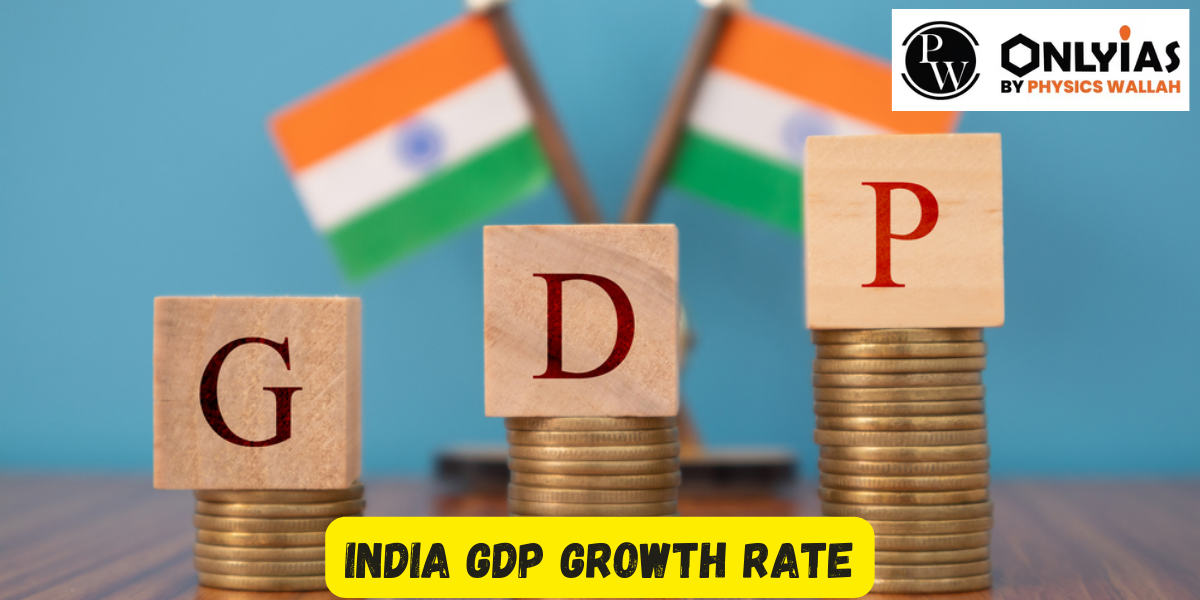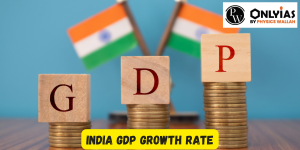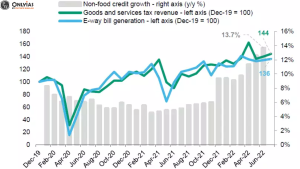India GDP growth rate: India's GDP (Gross Domestic Product) growth rate is a crucial economic indicator that reflects the country's economic performance.

India GDP growth rate: India’s GDP (Gross Domestic Product) growth rate is a crucial economic indicator that reflects the country’s economic performance over a specific period. Here, in this article we get into the trends, factors, and significance of India’s GDP growth rate.

India GDP growth rate: India’s economy exhibited robust growth, expanding by 7.8% in the April-June quarter, marking the highest growth rate in a year and slightly surpassing market expectations, which had anticipated a 7.7% expansion. The primary driver of this GDP growth was the impressive performance of the service sector, complemented by strong consumer demand and increased government capital expenditure.
Notably, private consumption, constituting nearly 60% of the economy, surged by approximately 6%, a substantial improvement compared to the 2.8% growth recorded in the preceding January-March period. Meanwhile, the growth in capital formation eased to around 8%, compared to the previous figure of 8.9%.
According to forecasts provided by the Reserve Bank of India, Asia’s third-largest economy is expected to continue its growth trajectory, with a projected expansion of 6.5% for the current fiscal year.
India GDP growth rate: According to official data from the National Statistical Office, India’s Gross Domestic Product (GDP) for the April-June quarter of the current fiscal year (2023-2024) expanded by 7.8 percent. This growth represents a notable improvement compared to the previous quarter, which saw a 6.1 percent GDP growth rate in the fiscal year 2022-23. India continues to maintain its status as one of the world’s fastest-growing major economies, particularly as China’s post-pandemic recovery has decelerated.
The reported GDP figure closely aligns with expectations in financial circles, as economists had anticipated that the economy would achieve its most rapid annual growth rate in a year. This growth was primarily attributed to the robust performance of the services sector and increased capital expenditure.
India GDP growth rate: The services sector stands as the linchpin of India’s economy, representing both its most significant and fastest-growing segment. Key components within this sector, including trade, hotels, transport, communication, financing, insurance, real estate, business services, community, social, and personal services, collectively contribute to over 60 percent of the country’s GDP.
In contrast, agriculture, forestry, and fishing, while constituting approximately 12 percent of India’s economic output, remain the primary source of employment for more than 50 percent of the labor force. Manufacturing follows closely, accounting for 15 percent of GDP, while construction contributes an additional 8 percent. The remaining 5 percent is distributed among sectors encompassing mining, quarrying, electricity, gas, and water supply.
The sectoral composition reflects the diverse economic landscape of India, with services driving substantial economic growth, while agriculture plays a vital role in sustaining employment for a significant portion of the population.
India’s GDP for the fiscal year 2022-23, which concluded in March 2023, expanded by 7.2%, slightly surpassing both the 7% figure in the second estimate and the government’s own forecast of 7%. Looking ahead to the financial year 2023-24, the central bank anticipates a GDP growth rate of 6.5%.
The most crucial and swiftest-growing sector within the Indian economy remains the services sector. This sector encompasses trade, hotels, transport, communication, financing, insurance, real estate, business services, as well as community, social, and personal services, together constituting over 60% of the country’s GDP.
In contrast, agriculture, forestry, and fishing, while contributing to approximately 12% of the nation’s economic output, remain the primary source of employment for over 50% of the labor force. Manufacturing follows closely, representing 15% of GDP, while construction accounts for an additional 8%. The remaining 5% is distributed among sectors such as mining, quarrying, electricity, gas, and water supply.
These sectoral dynamics underscore the diverse economic landscape of India, with services driving significant economic growth, while agriculture plays a pivotal role in providing employment opportunities for a substantial portion of the population.
India GDP Growth Rate 2020
India’s GDP growth rate for the year 2020 was significantly affected by the COVID-19 pandemic and the resulting economic challenges. According to data from the Reserve Bank of India (RBI), India’s GDP contracted by approximately 7.3% in the fiscal year 2020-2021 (April 2020 to March 2021). This contraction was primarily due to the nationwide lockdowns and disruptions in economic activities caused by the pandemic.
The annual percentage growth rate of GDP at market prices is calculated based on constant local currency, with aggregate figures presented in constant 2010 U.S. dollars. GDP represents the sum of gross value added by all resident producers in the economy, including any product taxes, and subtracts any subsidies not included in the value of the products. It is computed without accounting for deductions related to the depreciation of fabricated assets or the depletion and degradation of natural resources.
In terms of India’s GDP growth rates:


| Also Read: | |
| 7 Best Books for Indian Economy for UPSC 2024 | UPSC Economics Syllabus |
| India’s Economy | G20 Summit 2023 Delhi Schedule |
Official data from the National Statistical Office reveals that India's gross domestic product (GDP) for the current fiscal year (2023-2024) expanded by 7.8% in the April-June quarter. This growth surpasses the 6.1% recorded in the previous January-March quarter of the fiscal year 2022-2023.
The projected GDP growth rate for India in 2023 is 6.7%.
The United States of America (USA) has highest GDP in 2023.
The fastest growing economies Globally Guyana: Anticipated average growth from 2022 to 2026 - 25.8%. Guyana is poised to be the world's fastest-growing economy in the coming years. Macao: Expected average growth from 2022 to 2026 - 11.9%. Fiji: Predicted average growth from 2022 to 2026 - 7.7%. Niger: Expected average growth from 2022 to 2026 - 7.6%. Libya: Estimated average growth from 2022 to 2026 - 6.9%.

<div class="new-fform">
</div>